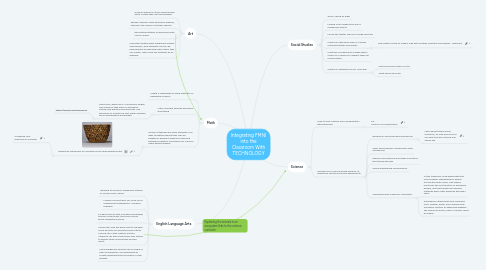
1. Art
1.1. Analyze writing on stone using google earth. Create their own pictographs
1.2. Reader's theatre using Aboriginal legends, upload to the school's youtube channel
1.3. Recreating patterns of wampums with colour coding
1.4. Using the multiple ways indigenous people used Buffalo, give students one tool Ex: pipecleaners and see how many items they can create. They could use Pinterest as an example.
2. Math
2.1. Create a videograph to show statistics of Residential schools
2.2. Math concepts through Aboriginal storytelling
2.2.1. Short films, which are 3-4 minutes in length. The scenarios take place in Aboriginal cultural and physical environments. The resolution of a particular plot always requires some mathematical knowledge.
2.2.1.1. https://vimeo.com/28020225
2.3. Online Notebooks will allow students of all ages to digitally weave their own 3D baskets of different shapes by choosing geometric patterns collected from Tla’amin cedar basket designs.
2.3.1. Interactive notebooks for creating Coast Salish basket motifs
2.3.1.1. Notebook Link: Welcome to Callysto!
3. English Language Arts
3.1. Listening to books by Indigenous authors on Tumble book Library
3.2. Making a movie trailor for a play by an Indigenous playwright EX: Tompson Highway
3.3. A Kahoot quiz to test formative knowledge during a novel study, the novel may be about residential schools.
3.4. Stories like How the Robin got its red beak could be used as a brainstorming activity. Turning into a text creation activity. Students can then create their own stories to explain other animals they wonder about.
3.5. Using Indigenous symbols like an eagle or bear as isnpiration. Use photoshop to create something that is symbolic of the student
4. Social Studies
4.1. Zoom calling an Elder
4.2. Making a info-graph time line of Indigenous events
4.3. Follow the twitter feed for Orange shirt day
4.4. Create an interactive map of Canada outlining treaties and events
4.4.1. Map creator online to make a map with multiple locations and regions - ZeeMaps
4.5. Creating a collaborative Coggle with a school on a reserve to address ideas for reconciliation.
4.6. Create an instagram bio for Louis Riel.
4.6.1. Who would he follow in 2019?
4.6.2. What would he post?
5. Science
5.1. Links to First Nations and Transportation with EduMedia
5.1.1. EX: History of Transportation
5.2. Wonderville A science based program of interactive games and online experiments
5.2.1. Building an online tipi with Wonderville
5.2.1.1. Learn about tensile force, insulation, air flow and more as you help to build a strong and sturdy tipi.
5.2.2. Learn about Buffalo Conservation with Wonderville
5.2.3. Physical and chemical processes involved in the tanning process
5.2.4. Canoe engineering and buoyancy
5.2.5. Cranberries and Classroom Chemistry
5.2.5.1. In this traditional Cree legend with the Cree trickster Wesawkechuk, whose encounters with a bear. This legend reinforces the oral tradition of Aboriginal people, and that traditional teaching methods were often achieved through a story.
5.2.5.2. Afterwards, students will test cranberry juice, vinegar, water, and a baking soda and water solution to determine whether the liquids are acidic, basic or neutral using pH paper.

